|
|
 |
|
Calanoida ( Order ) |
|
|
|
Calanoidea ( Superfamily ) |
|
|
|
Megacalanidae ( Family ) |
|
|
|
Elenacalanus ( Genus ) |
|
|
| |
Elenacalanus princeps (Brady, 1883) (F,M) | |
| | | | | | | Syn.: | Calanus princeps Brady, 1883 (p.36, figs.F); Giesbrecht, 1892 (p.300); Giesbrecht & Schmeil, 1898 (p.52);
Heterocalanus medius Wolfenden, 1906 (p.27); 1911 (p.201, figs.F);
Bathycalanus rigidus Sars, 1920 c (p.2); 1924/1925 (p.19, figs.F); Rose, 1929 (p.9, Descr.M, figs.M); Jespersen, 1934 (p.46); Wilson, 1936 c (p.90); Wilson, 1942 a (p.172);
Megacalanus princeps : Pearson, 1906 (p.6); Farran, 1908 b (p.21, Rem.); Wilson, 1942 a (p.193); C.B. Wilson, 1950 (p.262); Fagetti, 1962 (p.8); Morioka, 1972 a (p.314); Lozano Soldevilla & al., 1988 (p.57);
Macrocalanus princeps : With, 1915 (p.37, figs.F,M);
Bathycalanus princeps : Farran, 1939 (p.360, Rem.); Jespersen, 1940 (p.10); Vervoort, 1946 (p.70, Rem.); Farran & Vervoort, 1951 a (n°33, p.3, figs.F); Vervoort, 1963 b (p.87, Rem.); Grice & Hulsemann, 1967 (p.13); Michel, 1994 (p.186, Rem.); Bradford-Grieve & al., 1999 (p.877, 906, figs.F); Blanco-Bercial & al., 2011 (p.103, Table 1, Biol. mol, phylogeny); Ref. compl. : Grice & Hulsemann, 1967 (p.13), 1968 (tab.2); Björnberg, 1973 (p.303); Harding, 1974 (p.141, tab.2, gut contents); Childress, 1975 (p.787, respiratory rate); Deevey & Brooks, 1977 (p.256, Table 2, Station "S"); Razouls & al., 2000 (p.343, tab. 5, Appendix); Holmes, 2001 (p.35).
Nota: Synonymies after Bradford-Grieve & al. (2017, p.132) underline. (See in remarks, p.139 concerning doubtful identifications. | | | | Ref.: | | | Bradford-Grieve & al., 2017 (p.132, Descr. F,M, figs.F,M, Rem., fig.114: depth range) | 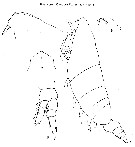 issued from : R.N. Wolfenden in Die Marinen Copepoden der Deutschen Südpolar-Expedition 1901-1903, 1911. [Pl.XL, Figs.1-5]. As Heterocalanus princeps Female: 1, habitus (lateral); 2-4, forehead (lateral, dorsolateral and dorsal, respectively); 5, P1. Nota after Bradford-Grieve & al. (1999, p.906): Female and Male with crest on dorsal forehead.
|
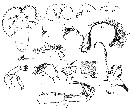 issued from : M. Rose in Result. Camp. Scient. Prince Albert Ier, Monaco, 1929, 78. [Pl. I, Figs.1]. As Bathycalanus rigidusMale (from 38°30'N, 34°40'W): D, habitus (dorsal); F, forehead with ocular patches (dorsal); A1; Co, dorsal medial process between the 1st and 2nd thoracic segments (lateral); R1, forehead with rostrum (lateral); R2, idem (frontal view); A1 B, proximal segments of the no geniculated A1; A1 prehensile A1; A2; Md (cutting edge); P, Md (mandibular palp); detail of mandibular palp); Mx1 (as Mx); Mxp (as Mxp2). Nota: - Head without crest, nor point forhead. - Rostrum with 2 blunted points, ventrally. - Posterior corners of 5th pedigerous somite rounded. - Dorsally, between the cephalon and the 1st pedigerous somite a strong and curved apophyse backward and into a deep hollow, relatively slightly prominent in lateral view. - A1 25-segmented, 8th and 9th segments fused, passing beyond the caudal rami. Right and left antennula asymmetrical, the left ordinary, 3rd segment bearing a very long seta not plumose. - Md gnathobase and masticatory edge strong with sharp teeth.
|
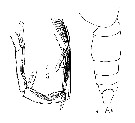 issued from : M. Rose in Result. Camp. Scient. Prince Albert Ier, Monaco, 1929, 78. [Pl. I, Figs.1]. As Bathycalanus rigidus.Male: G, double articulation of the prehensile A1; Ab, urosome (lateral right side). Nota:
- Abdomen 5-segmented, 2nd abdominal segment swollen, more longer than others;
- Caudal rami short, hirizontally divergent, 5 setae each ramus and on an horizontal line.
- Urosome about 1/5 the body length.
Anal segment very reducted.
Right A14 with an prehensile organ, median segments swollen, 2 geniculate articulations
|
 issued from : M. Rose in Result. Camp. Scient. Prince Albert Ier, Monaco, 1929, 78. [Pl. I, Figs.1]. As Bathycalanus rigidus. Male: Mx2 (as Mxp1); P1 to P5; P5 g, left P5; P5 Re dr, exopod of right P5; Re2 g, 2nd exopodite of left P5; C, detail of the inner element of the 2nd exopodite segment of left P5. Nota: P5 slightly asymmetrical, the left leg different, with a size more weak and the of the structure of the 2nd exopodal segment. On the left leg, basis bearing 2 spines on the outer margin, on the right leg only a tiny hair . On the right ramus, inner edges of the 3 article naked, hairies on the left ramus.
|
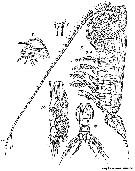 Issued from: G.O. Sars in Résult. Camp. Scient. Prince Albert I, 69, pls.1-127 (1924). [Pl.V, figs. 7, 8, 9, 12, 15]. As Bathycalanus rigidus. Female: 7, habitus (lateral); 8, forehead (lateral); 9, rostrum (frontal view); 12, P1; 15, urosome (dorsal). Nota: Rostrum with cylindrical round-ended filaments. P1 lacking outer spine on 1st and 2nd exopodal segments.
|
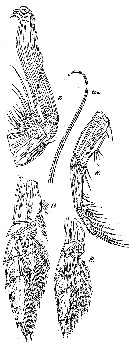 Issued from: G.O. Sars in Résult. Camp. Scient. Prince Albert I, 69, pls.1-127 (1924). [Pl.V, figs. 10, 10a, 11, 13, 14]. As Bathycalanus rigidus. Female: 10, Mx2; 10a, distal portion of a seta of Mx2; 11, Mxp; 13, P3; 14, P5. Nota: Distal setae of Mx2 elongate, densely spinulose, with curved tips.
|
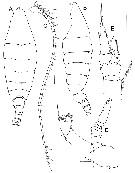 Issued from : J.M. Bradford-Grieve, L. Blanco-Bercial & G.A. Boxshall in Zootaxa, 2017, 4229 (1). [p.133, Fig.87]. Female (from 46.617°S, 75.800°W): A-B, habitus (dorsal and lateral, respectively); C, A1; D, A2; E, P1 (posterior view). Scale bars: 1.0 mm (A-C, E); 0.1 mm (D). Nota: - Anterior margin of head with low crest (in dorsal and lateral views); - Posterior corners of pediger 5 short and rounded. - Genital double-somite symmetrical in dorsal view, bulbous, wider than long; - A1 26-segmented (segments 8 and 9 imperfectly separate), extending beyond caudal rami by 6 segments. Ancestral segments I, II, III and V with dorsal surface hair sensillum and adjacent macula cribrosa, ancestral segment IV has only hair sensillum. - A2 ancestral exopodal segment IV without seta.
|
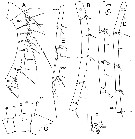 Issued from : J.M. Bradford-Grieve, L. Blanco-Bercial & G.A. Boxshall in Zootaxa, 2017, 4229 (1). [p.134, Fig.88]. Female: A, A1 ancestral segments I-XI; ; B, A1 ancestral segments XII-XVI; C, A1 ancestral segments XVII-XIX; D, A1 ancestral segments XX-XXIII; E, A1 ancestral segments XXIV-XXVIII; F, detail of ancestral segment XXVIII; G, ancestral segments I-V dorsal surface showing distribution of hair sensilla (hs) and maculae cribrosae (mc). Scale bars1.0 mm (A-E); 0.1 mmF, G).
|
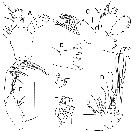 Issued from : J.M. Bradford-Grieve, L. Blanco-Bercial & G.A. Boxshall in Zootaxa, 2017, 4229 (1). [p.135, Fig.89]. Female: A, Md palp; B, Md gnathobase; C, Mx1; D, Mx2; E, endopod of Mx2; F, Mxp; G, terminal part of Mxp. Scale bars: 1.0 mm (D, F); 0.1 mm on remaining figures. Nota: - Mx1 basal endites 1 and 2 with 2 and 2 setae, respectively; endopd wegments with 1-2, 0-1,4+1 small anterior surface setae; basal exite without seta, epipodite with 7 long and 2 vestigial setae. - Mxp syncoxal endites with 1, 2 (1 vestigial), 4, 4 (1 vestigial) setae, longest seta on endite 4 extending as far as distal border of basis; endopod seglents 3-6 with 1, 1, 1 (no outer border seta but 1 macula cribrosa), 3 terminal setae (2 large and 1 small, no seta on outer border, respectively.
|
 Issued from : J.M. Bradford-Grieve, L. Blanco-Bercial & G.A. Boxshall in Zootaxa, 2017, 4229 (1). [p.136, Fig.90]. Female: A, P2 (anterior view); P3 (anterior view); C, P4 (anterior view); D, P5 (anterior view). Scale bar; 1.0 mm on all figures.
|
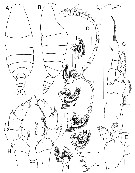 Issued from : J.M. Bradford-Grieve, L. Blanco-Bercial & G.A. Boxshall in Zootaxa, 2017, 4229 (1). [p.137, Fig.91]. Male (57.7°S, 138.1°): A-B, habitus (dorsal and lateral, respectively); C, detail of rostrum (lateral); D, right A1; E, Md palp; F, distal part of Md gnathobase; G, P1 (anterior view). Male (from 60°N, 20°W): H, P5 (posterior view); Specialised seta on left exopodal segment 2 of North Atlantic specimens: I, K (from 60°N, 20°W); M from 53°N, 20°W; N from 40°N, 20°W; J, L from 44°N, 13'W.Scale bars: 1.0 mm (A-D, G, H); 0.1 mm on remaining figures. Nota: - Anterior margin of head in dorsal and lateral views rounded, without crest.. - Rostrum ventrally-directed, bluntly tapering - Md basis with 3 setae; endopodal segment 2 with 9 setae. - Urosome of 5 free somites. - P5 slightly asymmetrical. Right exopodal segment 3 with tuft of proximal setules on inner border whereas left exopodal segment 3 inner border densely setulose. Exopodal segment 2 on left variable with characterised specialised inner distal seta made of 2 parts: basal part and setulose lash; basal part usually rectangular, distally setulose (in some specimens base slightly drawn out) and with setules at base of lash; setulose lash arising from proximal border of basal part. Left exopodal segment 3 carrying 1 terminal, 1 inner (at about distal 1/4) and 1 outer border spine (at distal 1/3rd; right exopodal segment 3 with 1 termial spine, 1 inner and 1 outer border spine positioned opposite each other. Macula cribrosa present on each basis and exopod segments 1-3.
|
 Issued from : J.M. Bradford-Grieve, L. Blanco-Bercial & G.A. Boxshall in Zootaxa, 2017, 4229 (1). [p.137, Fig.91]. Male (from 57.7°S, 138.1°W): A, left A1 ancestral segments I-XIV; B, left A1 ancestral segments XV-XX; C, left A1 ancestral segmentsXXI-XXIV; D, right A1 ancestral segments I-XII (arrow indicates clavate seta); E, right A1 ancestral segments XIII-XIX; F, right A1 ancestral segments XX-XXVIII; G, right A1 detail segment XXVIII; H, clavate seta on segment XI of right A1. Scale bats: 1.0 mm (A-F); 0.1 mm (G, H). Nota: A1 asymmetrically developed, geniculate on right; A1 ancestral segments I and II fused. On right side, segments XVI to XIX with narrow proximal anterior border ridge; fused gripping element on segment XIX extending distally well beyond insertion of aesthetasc; ancestral segment XX curved on shorter radius than in E. eltaninae; proximal fused gripping element of fused segments XXI-XXIII overlapping 2nd fused gripping element by about 40% of its length and gripping element 2 extending distally beyond base of small seta of incorporated segment XXIII. Left A1 segments XXV-XXVIII broken off.
|
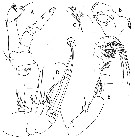 Issued from : J.M. Bradford-Grieve, L. Blanco-Bercial & G.A. Boxshall in Zootaxa, 2017, 4229 (1). [p.139, Fig.93]. Male (from 57.7°S, 138.1°W): A, A2; B, Mx1; C, Mx1 praecoxal arthrite; D, Mx2; E, Mxp. Scale bars: 0.1 mm (A-E). - Nota: - A2, Md, Mx1, Mxp, P1 to P4 as in female, although some setae on mouthparts may be reduced in size and number relative to female. - A2 ancestral endopod segments I-IV without setae. - Mx1 praecoxal arthrite with about 10 reduced setae, apparently none on posterior surf/0, 0, 4 setae; basal endites 1 and 2 with 2 and 0 setae, respectively; endopod segments with 1/0, 0, 4 setae; exopod with 11 setae; basal exite without seta, epipodite with 7 long setae, proximal 2 setae absent. - Mx2 as in female but setae weakly developed; 2 setae of basal endite and setae of endopod segments 1-4 long, distally weak and narrow therefore not holding their distal curl, lined distally with very dense, fine spinules. - Mxp syncoxa endites with 1, 2 (1 vestigial), 4, 3 setae, respectively, longest seta on endite 4 extending to distal seta of basis; endopod segments 3-6 with 1, 1, 1 (noouter border seta), 2 large setae and 1 short seta, respectively.
|
 Issued from : J.M. Bradford-Grieve, L. Blanco-Bercial & G.A. Boxshall in Zootaxa, 2017, 4229 (1). [p.91, Table 11]. Morphological characters after identification key of Elenacalanus females and males. Compare to other species of genus. Main characters identification after species key : 1 - Head with crest in female, rounded in male: male P5 right exopod segment 3 inner border with patch of proximal setules.
|
 Issued from M. Rose in Résult. Camp. scient. Prince Albert I, 1929, 78, p.9. Description du mâle de Bathycalanus rigidus [ = Elenacalanus princeps (Brady, 1883)] échantillonné à la station 3526 lors de la campagne de 1913.
|
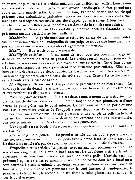 Issued from M. Rose in Résult. Camp. scient. Prince Albert I, 1929, 78, p.10. Suite de la description du mâle de Bathycalanus rigidus [ = Elenacalanus princeps (Brady, 1883)] échantillonné à la station 3526 lors de la campagne de 1913.
|
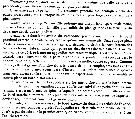 Issued from M. Rose in Résult. Camp. scient. Prince Albert I, 1929, 78, p.11. Suite de la description du mâle de Bathycalanus rigidus [ = Elenacalanus princeps (Brady, 1883)] échantillonné à la station 3526 lors de la campagne de 1913.
| | | | | NZ: | 10 + 3 doubtful | | |
|
Distribution map of Elenacalanus princeps by geographical zones
|
| | | | | | | | | | | | | Loc: | | | Antarct. (Drake Passage, SW & S Atlant., Indian: continent, S & SE Pacif., sub-Antarct. (SE Pacif.), ? G. of Guinea, ? Cape Verde Is., ? Canary Is., Azores, Sargasso Sea, Station "S" (32°10'N, 64°30'W), Bermuda, off E Cape Cod, off Woods Hole , Strait of Davis, S & W Ireland, Faroe Is., ? North Sea, SW Indian, ? off SE & S Hokkaido, ? S California, ?off SE Easter Is., Juan Fernandez Is., S Chile
Type locality: 38°34'N, 72°10'W.
Some localisations need confirmation (indicate by ? on the chart. See after restricted synonymies in Bradford-Grieve & al., 2017, p.141, fig.94). | | | | N: | 23 | | | | Lg.: | | | (1) F: 11; (7) F: 13,5; (10) F: 10,75; (49) F: 13,2-11,8; (787) F: 13-10,5; {F: 10,50-13,50}
After Bradford-Grieve & al. (2017, p.132, 135): (1316) F: 11,5-13,4 (mean = 12,5); M: 8,9; {F: 11,5-13,4; M: 8,9} | | | | Rem.: | Meso-Bathypelagic. Sampling depth (Antarct., sub-Antarct.) : 3000 m. In Sargasso Sea: 1000-1500 m (Deevey & Brooks, 1977, Station "S"); Sampling in vertical tow 2000-1000 m (Harding, 1974). Sample in a vertical haul from 2000 to surface for one male by Rose (1929) west of Azores.
Bradford-Grieve & al. (2017, p.140) note morphological variation: Setation of the endopod of the female Mx1 is variable on each side of the same individual examined. The shape of the male inner distal specialised seta of left P5 exopodal segment 2 is variable; the base may be very rectangular (Fig.91K-M), drawn out distally (Fig.91 I, J) or with a slight notch (Fig.91 N).E. princeps may be distinguished from the other four species by the crested head of the female (head rounded in the other 4 species), proximal seta of Mx1 coxal epipodite absent (present in all other species), and Mxp endopodal segment 6 with 3 setae (4 in most other species). The male P5 has the right exopodal segment 3 inner border with a proximal tuft of setules (in the other known species this border is naked).
For the authors, there has been much previous confusion about the identity of this species. Boxshall re-examined two of Brady's type specimens. The Mx1 characters confirm that Calanus princeps Brady, 1883 belongs to a genus separate from Megacalanus. The present female specimen Bathycalanus rigidus Sars (1924/1925), although some details differ from the present description agree with the description from Bradford-Grieve & al. (2017, p.132). Rose (1929) contains the only description of a male to date Among the specimens examined at the Smithsonian Institution where was one male (OS.M299526) that agrees with most details given by Rose (1929). Males were assigned to females mainly based on the fact that E. princeps females were the most common Elenacalanus species in the material, the males slightly smaller (9-10 mm; mean = 9.5 mm) than in E. eltaninae (10-10.5; mean = 10.2 mm).
The authors note that the sexual dimorphism of the limbs appears to be more extensive in E. princeps than in most other Megacalanidae.
Bradford-Grieve & al. (2017, p.139) note: There has been much previous confusion about the idendity of this species because Brady's (1883) description and drawings were sufficient only to place this taxon in the Megacalanidae. Boxshall re-examined two of Brady's type specimens, most of the limbs are in good condition in the female; Mx1 formula is: coxal endite without setae, basal endites 1 and 2 with 2, 1 setae respectively, endopod with 1, 1,4+1; P1 exopodal segments 1 and 2 lack outer spines, while segment 3 has 2 outer spines. These character states confirm that Calanus princeps Brady, 1883 belongs to a genus separate from Megacalanus, Bradycalanus, and Bathycalanus.
Farran (1939) recognised that the specimen called Calanus princeps by Brady (1883) were the same as the specimen described by Sars (1924/25) as Bathycalanus rigidus, consequently becomes a junior synonym of Elenacalanus princeps (Brady, 1883). | | | Last update : 10/08/2018 | |
|
|
 Any use of this site for a publication will be mentioned with the following reference : Any use of this site for a publication will be mentioned with the following reference :
Razouls C., Desreumaux N., Kouwenberg J. and de Bovée F., 2005-2025. - Biodiversity of Marine Planktonic Copepods (morphology, geographical distribution and biological data). Sorbonne University, CNRS. Available at http://copepodes.obs-banyuls.fr/en [Accessed January 01, 2026] © copyright 2005-2025 Sorbonne University, CNRS
|
|
 |
 |



















